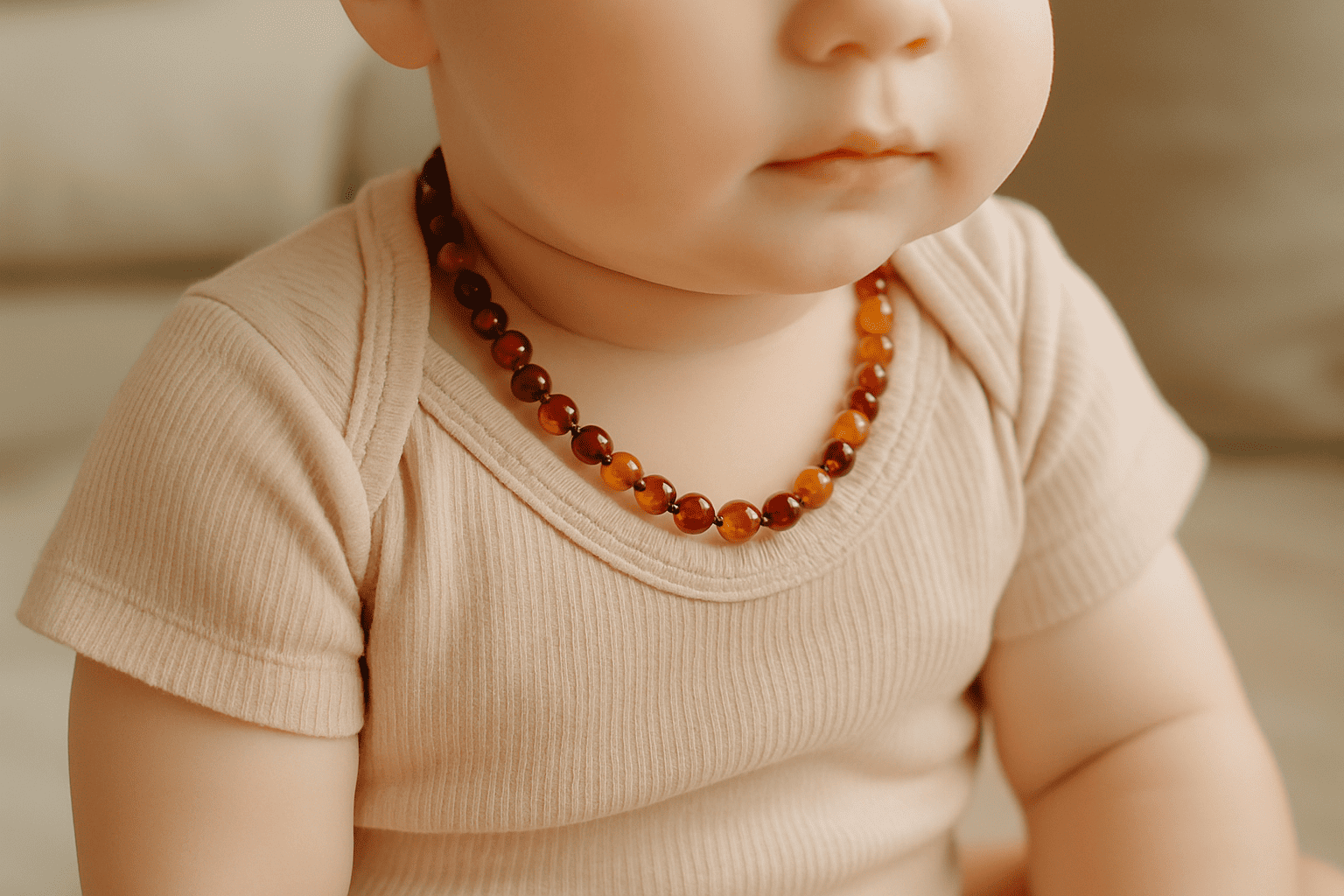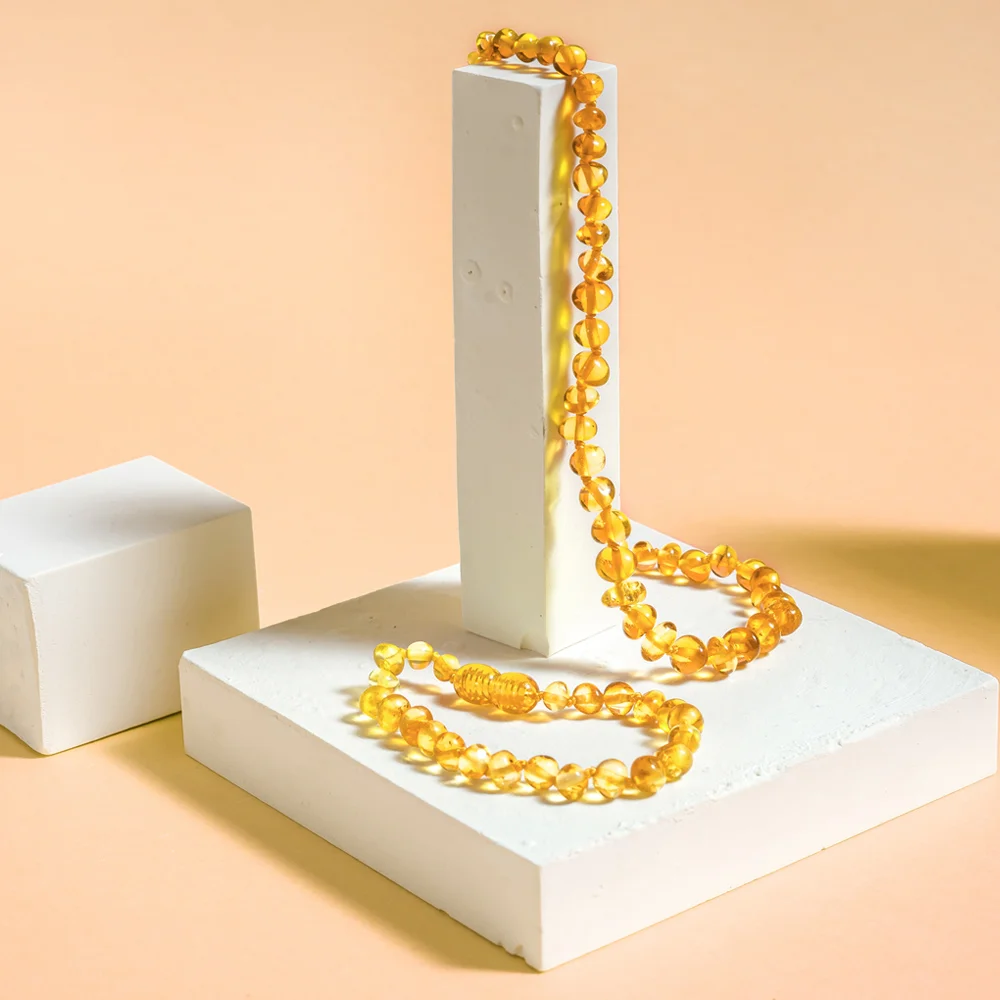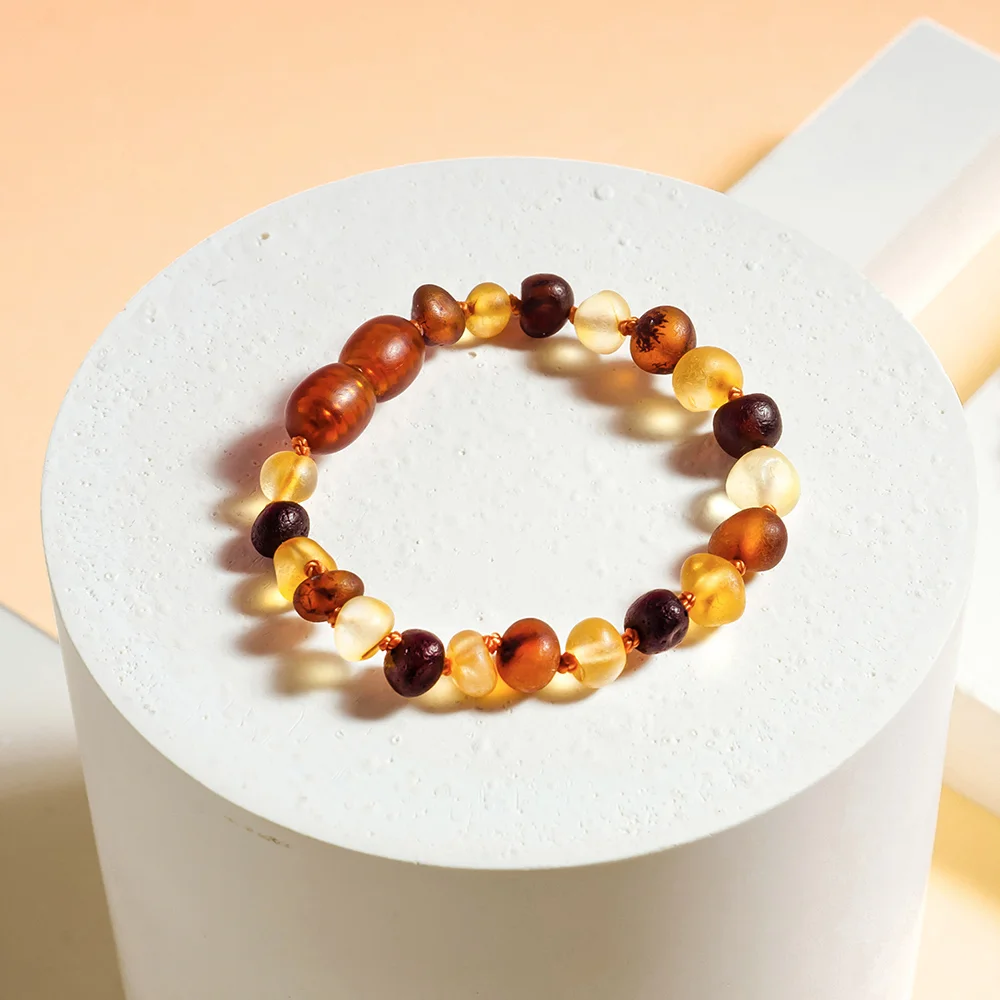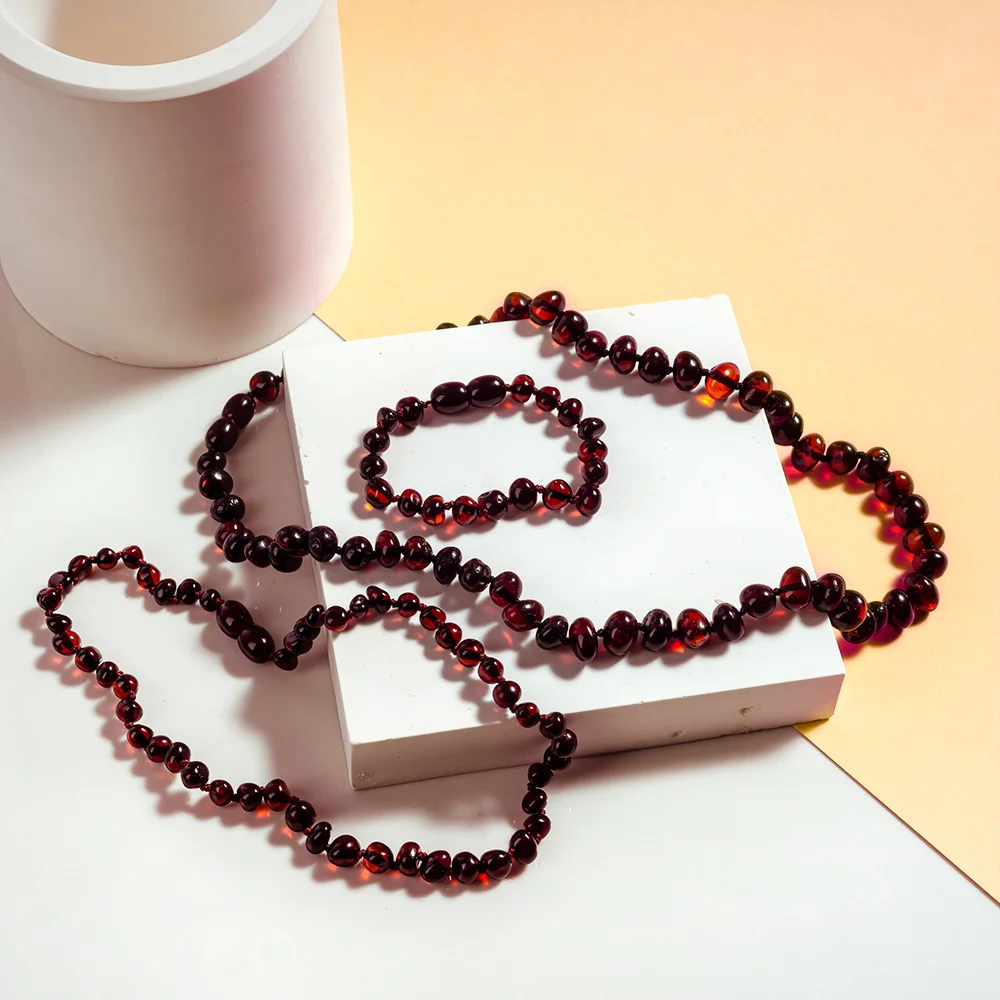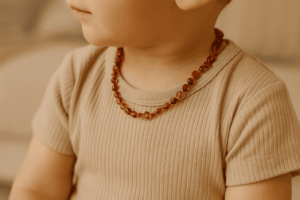Amber teething necklaces have become a popular choice among parents looking for natural ways to ease their baby’s teething discomfort. The warm, golden beads made from fossilized tree resin are worn close to the skin and are believed by supporters to release trace amounts of succinic acid, which may have soothing properties.
But a common question comes up for many families: Is it safe to leave an amber teething necklace on baby when he sleep? Parents often wonder if keeping it on through the night will maximize its potential benefits, or if it introduces unnecessary risks.
In this post, we’ll break down exactly what amber teething necklaces are, why some parents consider nighttime use, what experts say about safety, and practical alternatives to help your baby sleep comfortably without putting them at risk.
Understanding Amber Teething Necklaces
Amber teething necklaces are typically made from Baltic amber, a fossilized resin that formed millions of years ago in the forests surrounding the Baltic Sea. Each bead is polished and strung together to create lightweight jewelry that sits gently against the skin.
The idea behind their use is simple: when worn, the warmth from the baby’s skin may help release trace amounts of succinic acid from the amber, which supporters believe has anti-inflammatory or pain-relieving effects. While scientific evidence for these claims is limited, the necklaces have been embraced by some parents as part of a holistic approach to teething relief.
It’s important to note that amber teething necklaces are meant to be worn — not chewed. They are considered a form of jewelry, not a medical treatment. Because they’re designed for skin contact rather than oral use, their safety depends heavily on when and how they are worn, which is why the question of leaving an amber teething necklace on baby when he sleep is such a debated topic among parents and pediatric experts.
Why Parents Consider Nighttime Use?
For many families, teething is toughest at night. Babies who were relatively calm during the day can become restless, irritable, and difficult to settle once bedtime comes. The combination of gum discomfort, drooling, and interrupted sleep patterns can be exhausting for both the child and the parents.
It’s no surprise, then, that some parents wonder if keeping an amber teething necklace on their baby during sleep could help. The reasoning is straightforward: if amber’s soothing properties come from constant skin contact, then wearing it overnight might extend its potential benefits and provide more consistent relief.
In online parenting forums and social media groups, you’ll often find stories from parents who swear their little one slept more soundly when wearing amber around the clock. This anecdotal evidence fuels the belief that removing the necklace at bedtime might “interrupt” its effectiveness. For sleep-deprived parents desperate to help their child, the idea of an uninterrupted, gentle form of teething comfort can be tempting.
However, this leads to an important and often overlooked question — does leaving an amber teething necklace on baby when he sleep come with risks that outweigh any possible benefit?
The Safety Question: Amber Teething Necklace on Baby When He Sleep
While the appeal of continuous wear is understandable, every major health authority agrees on one thing: no necklace, including amber teething necklaces, should be worn by a sleeping baby. The primary concern is strangulation. Babies move unpredictably in their sleep, and a necklace can catch on bedding, clothing, or crib bars. Even in a caregiver’s presence, these incidents can happen silently and quickly.
There is also the choking risk if the necklace breaks. Although many amber teething necklaces are designed with safety clasps or knotted beads, these features are not foolproof. A single bead coming loose could pose a serious hazard.
Pediatricians, child safety organizations, and regulatory bodies such as the American Academy of Pediatrics and the U.S. Food and Drug Administration (FDA) consistently advise that necklaces should be removed before any sleep — whether it’s a short nap or an overnight stretch. The advice applies even if the baby sleeps in the same room as the parents.
In short, while the idea of leaving an amber teething necklace on baby when he sleep might sound harmless, the reality is that the risks are significant and preventable.
What Experts and Authorities Say
Health experts and child safety organizations around the world have addressed the question of whether it’s safe to leave an amber teething necklace on baby when he sleep — and their guidance is consistent. The American Academy of Pediatrics (AAP) warns that necklaces, regardless of material or purpose, should never be placed on a sleeping infant or toddler. The reasoning is simple: the potential for strangulation and choking far outweighs any perceived benefit.
The U.S. Food and Drug Administration (FDA) has also issued statements cautioning against the use of teething jewelry during sleep, pointing out that even products marketed as “baby-safe” can pose serious risks if worn unsupervised. Similar positions are held by child safety agencies in Canada, the UK, and across the European Union. In fact, some European countries require amber teething necklaces to carry clear warnings about removing them during naps and nighttime sleep.
These recommendations are not based on isolated incidents but on established safety principles. Infants are particularly vulnerable because their neck muscles are still developing, their airways are smaller, and they cannot remove an obstruction on their own. As a result, even a brief entanglement can have dangerous consequences.
The Science and Evidence
When discussing whether amber should be worn at night, it’s worth considering what the science says about its effectiveness. The popular belief is that Baltic amber contains succinic acid, which is released in tiny amounts when warmed by the skin, potentially offering anti-inflammatory or pain-relieving effects. However, scientific studies have not confirmed that this transfer occurs in a way that meaningfully reduces teething discomfort.
In fact, there is no peer-reviewed evidence showing that amber necklaces provide measurable relief from teething pain — during the day or at night. Most reports of benefits come from anecdotal experiences shared by parents, which, while valuable, are not a substitute for scientific proof.
This is important because it reframes the nighttime question: if there is no strong evidence that amber necklaces help, then leaving an amber teething necklace on baby when he sleep is essentially taking on safety risks without guaranteed rewards. That doesn’t mean amber jewelry has no value — many parents appreciate it for cultural, sentimental, or aesthetic reasons — but it does mean that safe usage should always be the priority.
Safe Alternatives for Nighttime Teething Relief
If your baby struggles with teething pain at night, there are several safe, pediatrician-recommended ways to provide comfort without the risks that come from leaving an amber teething necklace on baby when he sleep.
One of the simplest options is to offer a silicone teething toy before bedtime. These are designed to be chewed, are free from choking hazards when used as intended, and can help massage sore gums. For an extra soothing effect, you can chill the teether in the refrigerator (never the freezer) to provide gentle cooling relief.
A cold, damp washcloth is another classic home remedy. Twist the cloth, chill it in the fridge, and let your baby chew on it under supervision before bed. The combination of pressure and cold helps reduce inflammation and distracts from discomfort.
For more persistent pain, consult your pediatrician about age-appropriate over-the-counter pain relief, such as infant acetaminophen or ibuprofen. These should only be given according to medical advice and dosing guidelines.
Non-physical comfort measures can also be effective. Gentle rocking, white noise, dim lighting, and a calming bedtime routine all help your baby settle more easily, even during teething phases. The key is to address discomfort before sleep, so your baby can rest safely without wearing jewelry.
Daytime Use and Safety Guidelines
While it’s not safe to leave an amber teething necklace on baby when he sleep, some parents choose to use them during the day under direct supervision. If you decide to do this, following strict safety practices is essential.
First, make sure the necklace fits properly — it should be short enough that your baby can’t lift it over their chin, yet loose enough to sit comfortably against the skin. Many quality amber necklaces for babies are about 12 to 13 inches in length, but always check the sizing for your child.
Inspect the necklace regularly for signs of wear, such as fraying string, loose clasps, or cracked beads. Authentic amber is relatively soft compared to other gemstones, so it’s prone to surface wear over time. Replace the necklace if you notice any damage that could increase the risk of breakage.
Remove the necklace during naps, car rides, or any time your baby will be unsupervised — even for a few minutes. When it’s not in use, store it in a safe place out of your baby’s reach.
By keeping amber necklaces a daytime-only accessory and following these guidelines, you can reduce potential hazards while still enjoying them as part of your baby’s teething comfort routine.

